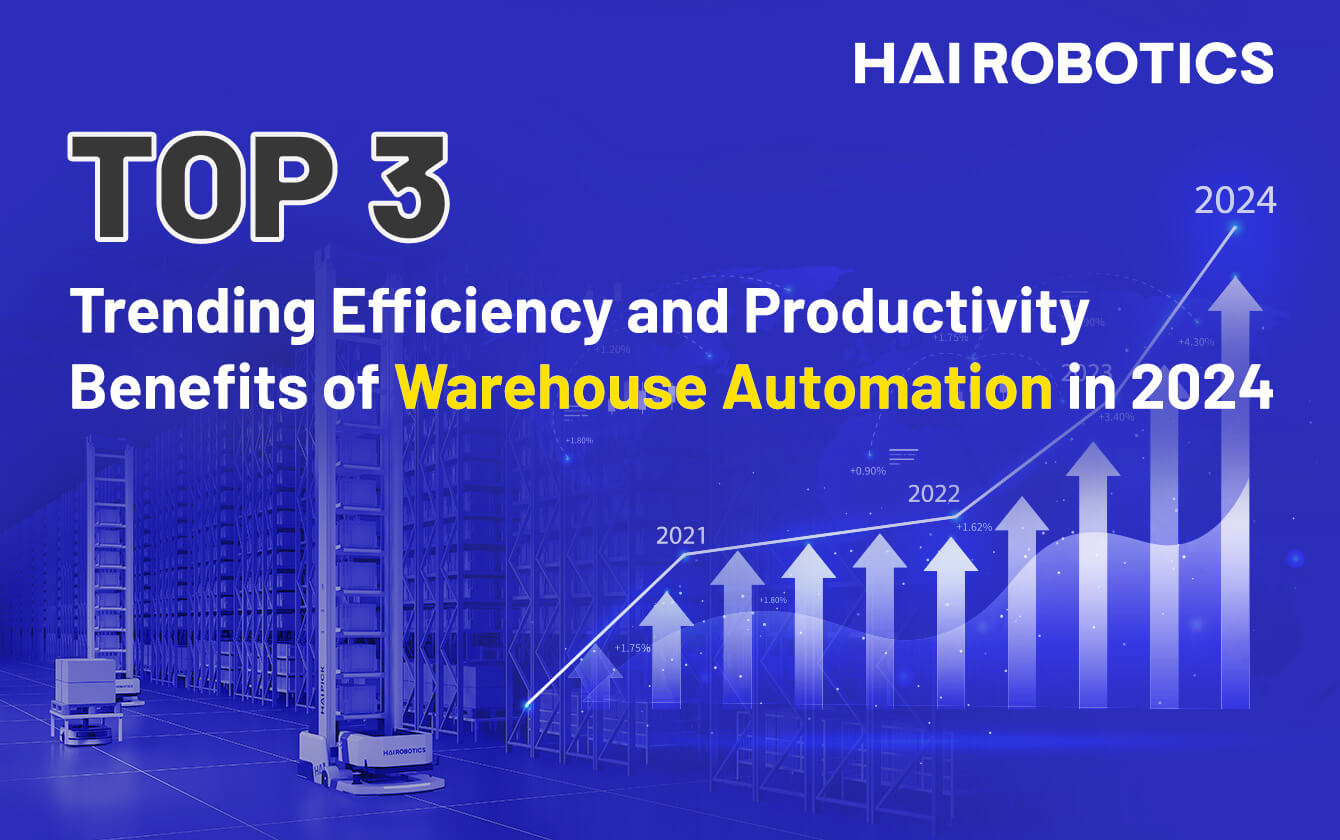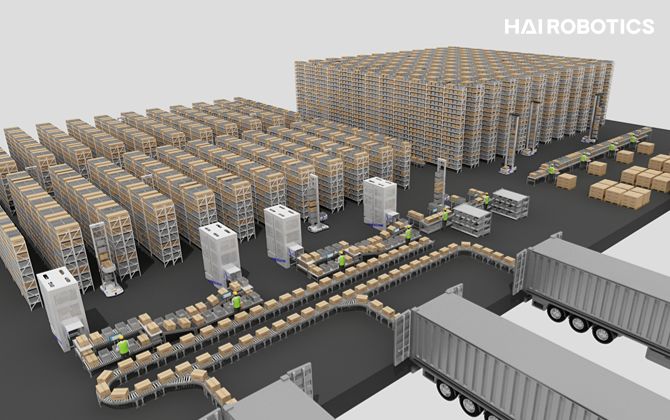Top 3 Trending Efficiency and Productivity Benefits of Warehouse Automation in 2024
Introduction:
If increased efficiency and productivity are what you're looking for, then wait no more. You can expect a massive shift in momentum toward warehouse automation for major industries worldwide.
In 2024, the pendulum will swing back in favor of warehouse construction and automation. While expenditure in these areas has flagged in recent years, according to MIDCOM. "Companies are gearing up to invest heavily in automation....with a notable resurgence in warehouse construction."¹
This will skyrocket the demand for warehouse automation solutions, which is on par to grow by 1.5 times by mid-2025.
While staying up-to-date on trends, businesses need to understand how automation and digitization help companies achieve vital efficiency and productivity goals.
With the ever-evolving world of supply chain logistics, the efficiency and effectiveness of warehouse operations have taken on pivotal importance in the global economic landscape of 2024. Warehouse automation has transformed how businesses approach inventory and order management–largely, by creating more secure, productive, and profitable environments. Warehouse automation robotic solutions such as smart warehouse solutions and automated storage retrieval systems (ASRS) have boosted efficiency and performance from huge echoing facilities to compact, urban Micro Fulfillment Centers (MFCs).
The shift from cumbersome person-to-goods traditional manual workflows to straightforward and modern goods-to-person automated solutions is advancing logistics performance and shaping the future of supply chain optimization.
 Below, we delve into the three key drivers fuelling this accelerated transformation of warehousing going into 2024 and beyond.
Below, we delve into the three key drivers fuelling this accelerated transformation of warehousing going into 2024 and beyond.
1. Maximized Space Utilization
Smart warehouse solutions can safely maximize warehouse storage space beyond what we previously thought possible. Two essential ways automated warehouses accomplish this are:
-
Narrowing the aisles
-
Heightening the racks
Since machines require less space than humans to operate, automated warehouses do not require additional aisle spacing to meet safety standards, which can improve storage utilization. Additionally, automated solutions allow for high-rise shelves that increase the vertical storage capacity of goods up to ten times that of an ordinary warehouse.
A 2022 whitepaper fielded by Jones Lang LaSalle, a leading professional services firm specializing in real estate management discovered that "[to] maximise land usage, mechanization, and automation technology can help increase floor efficiency."²
They continued that some automation solutions "can increase storage capacity by up to four times over the same facility footprint. AS/RS facilities are also typically taller, providing significantly more cubic space than traditional warehouse facilities."
Warehouse automation is a proven measure to save on expensive real estate and helps hit sustainability and other ESG targets.
85% of floor space can be saved by using Automated Storage Retrieval Systems (ASRS)³ because they maximize the cubic volume within a building. Some ASRS solutions which deploy goods-to-person Automated Case-handling Mobile Robots (ACR), and Autonomous Mobile Robots (AMR) can grant over 400% storage density.
Among their many advantages, ASRS provide highly compressed storage of items. This saves up to 85% of floorspace because they maximize cubic volume within a building, especially vertically.⁴
2. Increased Warehouse Productivity
Combining the speed and accuracy of robotics with the creative ability and cognitive power of humans makes for a winning combination for any warehouse.
"We’re not getting people out of the equation." Claims Jeff Burnstein from the Association for Advancing Automation "People are critical to the success of the adoption of robotics. So, what we’re seeing is people doing better, safer, and higher paying jobs."⁵
-
Automation systems can identify the location of all items in a particular order almost instantly, which means valued workers can spend less time hunting for or re-picking the right goods. Furthermore, warehouse automation can also speed up order fulfillment when adopting automated warehouse robots and conveyor workstations.
In a 2021 study conducted by Cognitive Robotics Journal, "Factories are now seeing a spike in the number of autonomous robots that can operate together to increase productivity and performance...." It further concludes that "automation leads to the largest productivity with the lowest expenditure."⁶
Not only does it save on capital, but it also saves on labor shortages when retention and recruitment advantages are undercut by sudden uncertainty, such as the recent pandemic.
Supply Chain Digital interviewed our partner Honeywell's President of Warehouse Automation, Keith Fisher, who believes "intelligent automated sortation equipment" and the AMR collaborative approach to automation tech is the gold standard when it comes both to easing warehouse labor issues, and the pressing need for lightning-quick last-mile logistics.
“This is enabling many companies to offset labor shortages,” he says. “Sortation technology boosts efficiency by combining items from multiple locations, to improve order processing time and accuracy.⁷
3. Elevating Employee Efficiency & Satisfaction
MHI, the largest material handling, logistics, and supply chain association in the United States, reports that "automated storage and retrieval systems provide a variety of benefits", including "increasing ergonomics by delivering items to the operator at a convenient height, eliminating time lost to walking, searching, lifting, bending and twisting."⁸
MHI also asserts that warehouse automation increases throughput capabilities and can increase labor productivity by up to 85% compared to traditional manual facilities. Warehouse automation streamlines mundane, repetitive, and time-consuming tasks by decreasing touch points for a smoother workflow, so workers can focus on tackling more rewarding, high-value projects.
Goods-to-person warehouse automation can also improve recruitment and employee retention, according to a recent Forbes improved recruitment and retention. Automated Case-handling Mobile Robots (ACR), and Autonomous Mobile Robots (AMR) and carousels transport products directly to employees instead of forcing them to walk tens of thousands of steps and up ladders to products. Retention stays high when companies actively reduce arduous, even sometimes unsafe travel back and forth for employees.⁹
By decreasing the need for recruiting and training temporary workers during busy periods and allowing valued employees to focus on customer-centric tasks, warehouse automation helps skilled workers where they're needed most.
According to a study conducted by the Harvard Business Review, "many workers felt that automated tools not only helped them do a better job on discrete tasks, but also freed up their time for more interesting work, helping them stay motivated and engaged."¹⁰ The study interviewed a French warehouse worker, Fabien, who appreciated how “working with robots makes the job more interesting. It saves you time because you have to go looking for information…everything is already integrated and digested by the robots.”
Allowing workers to focus on key duties through automated processes helps avoid any unnecessary waste of resources at each step in the supply chain and enhances productivity.
Conclusion
A recent Salesforce survey found 89% of full-time workers are more satisfied with their job due to automation. And 91% say automation saves them time and offers better work-life balance.¹¹ In 2024, warehouse automation significantly optimizes space use, improves worker productivity and satisfaction, and enhances overall performance.
By increasing storage capacity, automation not only cuts real estate costs but also aligns with sustainability and ESG goals. It enhances labor intensity, which improves job satisfaction vital for workforce retention. The blend of manual labor with automation boosts warehouse efficiency, ensuring speed, accuracy, and cost-effectiveness.
All of the above plays a crucial role in global economics by lighting the way toward supply chain alignment through transparent data analysis.
Focusing on integrating the workforce in tech-enabled environments ushers new opportunities, driving the future logistics industry to adopt more advanced solutions.
Footnotes
1) Technologies, MIDCOM Data. 2023. “Warehousing & Logistics Trends to Watch out for in 2024.” www.prnewswire.com. September 26, 2023.
2) Guevarra , Peter . 2022. “Mechanisation and Automation: Powering Smarter, Faster Logistics Content 01.” www.jll.com.sg.
3) Specter, Sara. 2019. “Need Dense Storage? There’s an AS/RS for That.” Warehouse Automation. July 10, 2019.
4) Industry Size.2023. "ASRS Infographic." MHI.com. Material Handling Industries.
5) Jeff, Burnstein. 2022. “Centre Stage.” Manufacturing Automation, October 2022.
6) Javaid, Mohd, Abid Haleem, Ravi Pratap Singh, and Rajiv Suman. 2021. “Substantial Capabilities of Robotics in Enhancing Industry 4.0 Implementation.” Cognitive Robotics1 (1): 58–75.
7) Ashcroft, Sean. 2023. “Automation ‘Easing Warehouse Labour Shortage’ Says Honeywell.” Supplychaindigital.com. April 17, 2023.
8) MHI. 2023. “Automated Storage and Retrieval Systems.” www.mhi.org. Material Handling Industry. December 1, 2023.
9) Beasley, Kevin. 2023. “Warehouse Automation and Employee Retention: Friends or Foes?” Forbes. Forbes Technology Council. October 23, 2023.
10) Lui, Joe, Raghav Narsalay, Rushda Afzal, Ida Nair Sharma, and Dave Light. 2022. “Research: How Do Warehouse Workers Feel about Automation?” Harvard Business Review. February 11, 2022.
11) Einstein Automate. 2021. “New Salesforce Research Links Lower Stress Levels and Business Automation.” Salesforce. December 2, 2021.

